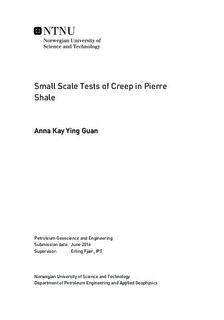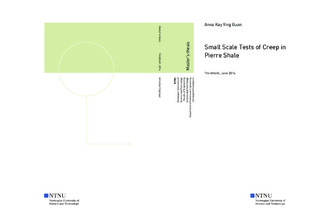| dc.description.abstract | The impressive scope of using shale as a permanent well barrier for plug and abandonment (P&A) operations has lately gained much attention in the petroleum industry. Shale is observed to have a natural self-sealing effect as a result of delayed deformation of the rock. This effect is most likely related to creep. Creep tests in the laboratory are normally done on standard core plugs, but these tests are very time-consuming due to ion and temperature diffusion. This thesis will therefore use small mm-size samples to study the creep properties in shale, utilizing a technology developed by SINTEF Petroleum Research. As the use of small samples involves pure shear failure, the effect of pore pressure is minimized.
The objective of this Master s thesis is to investigate the applicability of small scale tests of creep in Pierre shale, through a study on how chemical properties of the pore fluid affect the creep process, primarily pH and chemical activity. The experiments are performed with a shale puncher tool on 3 mm samples, saturated with either marcol oil, brine or hydrochloric acid. The testing procedure involves applying an axial force on the puncher tool, preferably in displacement control, while measuring the axial displacement and force. Creep experiments are conducted in order to study the creep development under constant load, while strain-rate tests are run with various rates of deformation to examine the resulting effect. The P-wave velocity of the samples is also measured through continuous wave technique (CWT) in order to quantify the sample heterogeneity.
The proposed study revealed that Pierre shale undergoes an extensive time-dependent deformation in response to applied axial force. In the creep tests, it is observed that the maximum axial force required to punch the sample is dependent on the loading path and the duration of each loading. In the strain-rate tests, it is found that the weakest sample is the one with fastest displacement rate, indicating that there may exist a pore pressure effect. A time-dependent effect is also observed in response to fluid exposure; an increase in P-wave velocity for the oil-saturated samples, and conversely a decrease for the brine-rich samples. Brine is used to alter the chemical properties of the pore fluid, while a change of pH is obtained by the use of hydrochloric acid. The effect of fluid exposure is shown to be of significance, as a considerably weakening in rock strength of the samples is seen. The experimental results proved the possibility in obtaining some information about creep behaviour using the puncher technology. However, further investigation and improvements are required before any applicable conclusions can be drawn. | |

